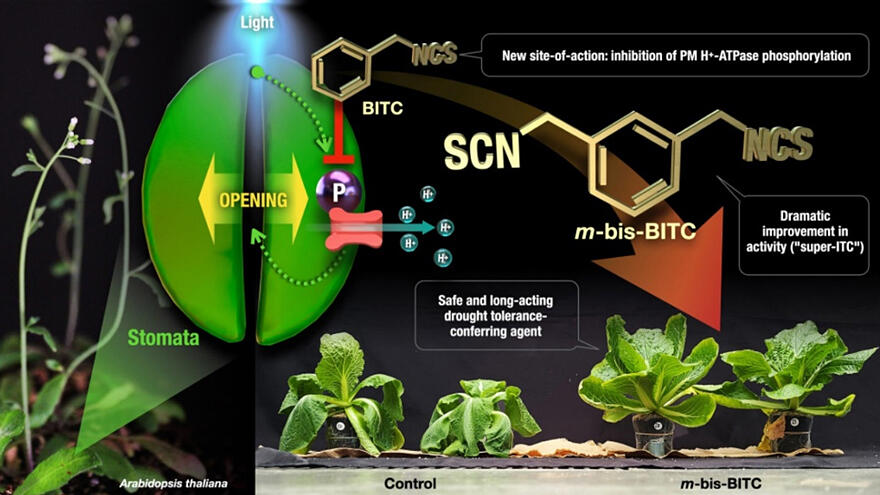A research group led by Professor Toshinori Kinoshita, Designated Associate Professor Ayato Sato, and Designated Lecturer Yusuke Aihara of the Institute of Transformative Bio-Molecules (WPI-ITbM), Graduate School of Science, Nagoya University, in collaboration with Associate Professor Kei Murakami of the School of Science Department of Chemistry at Kwansei Gakuin University, announced that they have discovered a natural compound that inhibits stomatal opening in plants. Benzyl isothiocyanate (BITC), which is present in Brassicales plants, inhibits stomatal opening by suppressing the activity of the plasma membrane proton pump (the engine of stomatal opening). By modifying the structure of BITC, they succeeded in improving its activity and suppressing its side effects. The results are expected to aid in developing drought tolerance-conferring agrochemicals and freshness-retaining agents for cut flowers. The results were published in the May 15th issue of the international academic journal Nature Communications.

(Yusuke Aihara, et al. Nature Communications. May 15, 2023)
Provided by Issey Takahashi, Institute of Transformative Bio-Molecules (WPI-ITbM), Nagoya University
The epidermis of plants contains many stomatal pores that are responsible for gas exchange, such as the uptake of carbon dioxide necessary for photosynthesis. Stomatal pores are composed of a pair of guard cells and open in response to the blue light contained in sunlight. Their closure is mediated by abscisic acid, a plant hormone biosynthesized in response to dark conditions and drought stress.
To date, the research group has clarified the main mechanism of stomatal opening. Additionally, they have created genetically modified plants to demonstrate that the promotion of stomatal opening could increase the photosynthetic activity and yield of plants, and that drought tolerance was improved in plants with accelerated stomatal closure. However, because the use of genetically modified plants has been difficult to spread, they screened 30,000 compounds that affect stomatal opening, aiming to control stomatal opening without relying on genetic modification. They reported a stomatal closing compound (SCL). Although they confirmed that spraying SCL on cut rose leaves could suppress wilting, SCL was active only on specific plant species and its activity was weak.
In this study, the Nagoya University research group searched for natural compounds that act on a wide range of plant species at low concentrations, are less toxic, and effective in inhibiting stomatal opening. In addition to the previous screening, 380 existing compound libraries were screened using stomata of Commelina benghalensis, a plant commonly used in stomatal research. As a result, they discovered BITC.
BITC, a compound with one NCS (isothiocyanate) group attached to the benzene ring, is the pungent ingredient found in mustard and horseradish. A natural metabolite of Brassicales plants, BITC has resistant effects against insects, bacteria, and fungi, but its mechanism of action in plants is unknown. When a drug that forces activation of the plasma membrane proton pump was applied to the stomata of C. benghalensis, the stomata opened wide, but when BITC was applied in advance, the stomata did not open. Phosphorylation, an indicator of plasma membrane proton pump activation, was also inhibited in BITC-pretreated stomata and mesophyll cells.
The leaves of cut Chrysanthemum flowers that had been soaked in BITC and then drained were confirmed to show inhibited wilting compared with the control group (no BITC application). The researchers further investigated the development of compounds that enhanced this activity.
The group prepared 40 compounds with various functional groups added to BITC and verified their effects. As a result, an analog of this compound with multiple NSC groups (Super ITC) showed notably higher activity than BITC. m-bis-BITC with two NCS groups exhibited 17-fold higher activity, whereas tris-BITC with three NCS groups exhibited 66-fold higher activity. Moreover, the activity of m-bis-BITC was higher than that of abscisic acid and exerted inhibitory effects on the wilting of cut Chrysanthemum flowers at one-fiftieth the amount of BICT. This effect lasted longer (more than 48 hours) than that of abscisic acid, and side effects (wilting of leaf tip) were reduced.
An experiment using Napa cabbage planted in a pot demonstrated that the control (no application) wilted 24 hours after draining, whereas the m-bis-BITC-treated plants remained fresh, indicating that m-bis-BITC could confer long drought tolerance. The experiment also confirmed that continuous application to plants did not adversely affect their growth. Even Super ITC was considered highly safe because the effects wear off in a few days. The research group will promote production with their partner companies as well as conduct further screening and safety evaluations.
Aihara commented, "In terms of applications, since the substance is deeply rooted in our food culture as a spice, I expect that this will lead to the development of applications such as freshness-retaining agents that ensure safety even in applications where it is exposed to our mouths. We believe that Super ITC can be used for a wide range of plants and applications, such as preserving the freshness of cut flowers in general or conferring drought tolerance to crop plants grown in arid regions."
This article has been translated by JST with permission from The Science News Ltd. (https://sci-news.co.jp/). Unauthorized reproduction of the article and photographs is prohibited.




